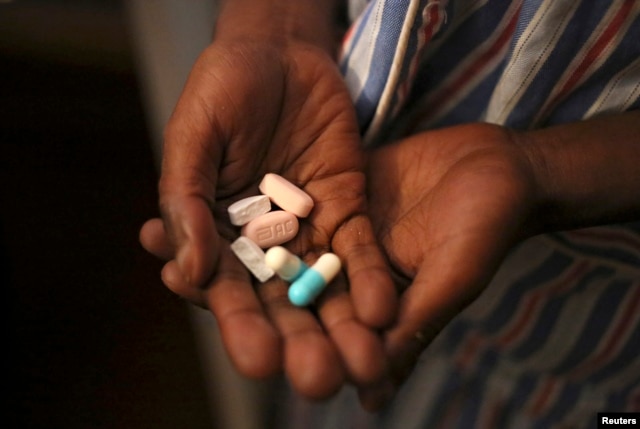$12 Billion Annual Gap Threatens Fight Against HIV/AIDS

Positive news exists. The United Nations Millennium Development Goal to slow the spread of HIV/AIDS exceeded its target set in 2000. UNAIDS reports a 35 percent decrease in HIV infections since then, while AIDS-related deaths have fallen by 42 percent over the past 11 years. Meanwhile, an increase of 84 percent of infected patients have gained access to antiretroviral therapy since 2010.
FILE – Nine-year-old Tumelo takes antiretroviral pills before at Nkosi’s Haven, south of Johannesburg, Nov. 28, 2014. Nkosi’s Haven provides residential care for destitute HIV-positive mothers and their children.
Despite these achievements, low- and middle-income countries continue to carry the burden of new infections and gaps in access to treatment. ONE, a global advocacy organization to end extreme poverty and preventable diseases, warns that governments and donors have become complacent in the battle to end the epidemic.
In an interview with VOA, Erin Hohlfelder, director of global health policy at ONE, warned of a critical «five-year window» in which efforts must be scaled up to fill a $12 billion annual financing gap in order to eliminate the disease by 2030, or otherwise risk a loss in gains and a rise in new infections.
She says it’s important that the governments of heavily impacted African countries, in addition to traditional donor governments, act with urgency. Sub-Saharan Africa, according to ONE, accounts for 70 percent of all people living with HIV today. While the annual price of treatment has decreased from nearly $10,000 10 years ago to less than $200 today, millions still lack access to treatment.
‘Fatigue in this fight’
The World Health Organization reports that fewer than 16 million out of 37 million people living with HIV were receiving antiretroviral therapy in 2015. Hohlfelder says a greater collective political will is necessary to provide the billions of dollars required to treat those who can’t afford it.
«We now know that when someone is on treatment regularly, they’re up to 96 percent less likely to pass HIV on. So we need to do much more to use treatment as prevention, both on the African continent, but also globally,» Hohlfelder said.
Forty-six Sub-Saharan African leaders have committed to spending 15 percent of their budgets on health, but only six are doing so, according to the 2015 ONE AIDS Report. It’s important, Hohlfelder stresses, that these governments are held accountable by their constituents.
«We’ve been at this fight for so long — for more than three decades — that it’s easy to feel a sense of fatigue in this fight, but we need citizens around the world and media outlets to help amplify these messages and to remind world leaders that we are holding them accountable for their promises.»
The ONE campaign reports that an increase in 1 percent of health funding by the remaining 40 Sub-Saharan African countries that have pledged support — with one-fifth of that increase directed to AIDS programs — could provide more than 7 million people with the antiretroviral drugs necessary to combat the disease.


